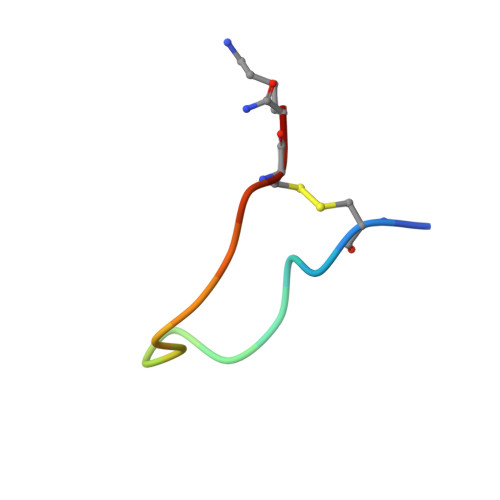Structure-based design of an indolicidin peptide analogue with increased protease stability
Rozek, A., Powers, J.P., Friedrich, C.L., Hancock, R.E.(2003) Biochemistry 42: 14130-14138
- PubMed: 14640680
- DOI: https://doi.org/10.1021/bi035643g
- Primary Citation of Related Structures:
1QX9, 1QXQ - PubMed Abstract:
Indolicidin is an antimicrobial cationic peptide with broad-spectrum activity isolated from bovine neutrophils. An indolicidin analogue CP-11, ILKKWPWWPWRRK-NH(2), with improved activity against Gram-negative bacteria had increased positive charge and amphipathicity while maintaining the short length of the parent molecule. The structure of CP-11 in the presence of dodecylphosphocholine (DPC) micelles was determined using nuclear magnetic resonance spectroscopy. CP-11 was found to be an amphipathic molecule with a U-shaped backbone bringing the N- and C-termini in close proximity. On the basis of this close proximity, a cyclic disulfide-bonded peptide cycloCP-11, ICLKKWPWWPWRRCK-NH(2), was designed to stabilize the lipid-bound structure and to increase protease resistance. The three-dimensional structure of cycloCP-11 was determined under the same conditions as for the linear peptide and was found to be similar to CP-11. Both CP-11 and cycloCP-11 associated with phospholipid membranes in a similar manner as indicated by circular dichroism and fluorescence spectra. The minimal inhibitory concentrations of CP-11 and cycloCP-11 for a range of bacteria differed by no more than 2-fold, and they were nonhemolytic at concentrations up to 256 microg/mL. Cyclization was found to greatly increase protease stability. The half-life of cycloCP-11 in the presence of trypsin was increased by 4.5-fold from 4 to 18 min. More importantly, the antibacterial activity of cycloCP-11, but not that of CP-11, in the presence of trypsin was completely retained up to 90 min since the major degradation product was equally active. A structural comparison of CP-11 and cycloCP-11 revealed that the higher trypsin resistance of cycloCP-11 may be due to the more compact packing of lysine and tryptophan side chains. These findings suggest that cyclization may serve as an important strategy in the rational design of antimicrobial peptides.
Organizational Affiliation:
Department of Microbiology and Immunology, University of British Columbia, #300-6174 University Boulevard, Vancouver, British Columbia, Canada.














